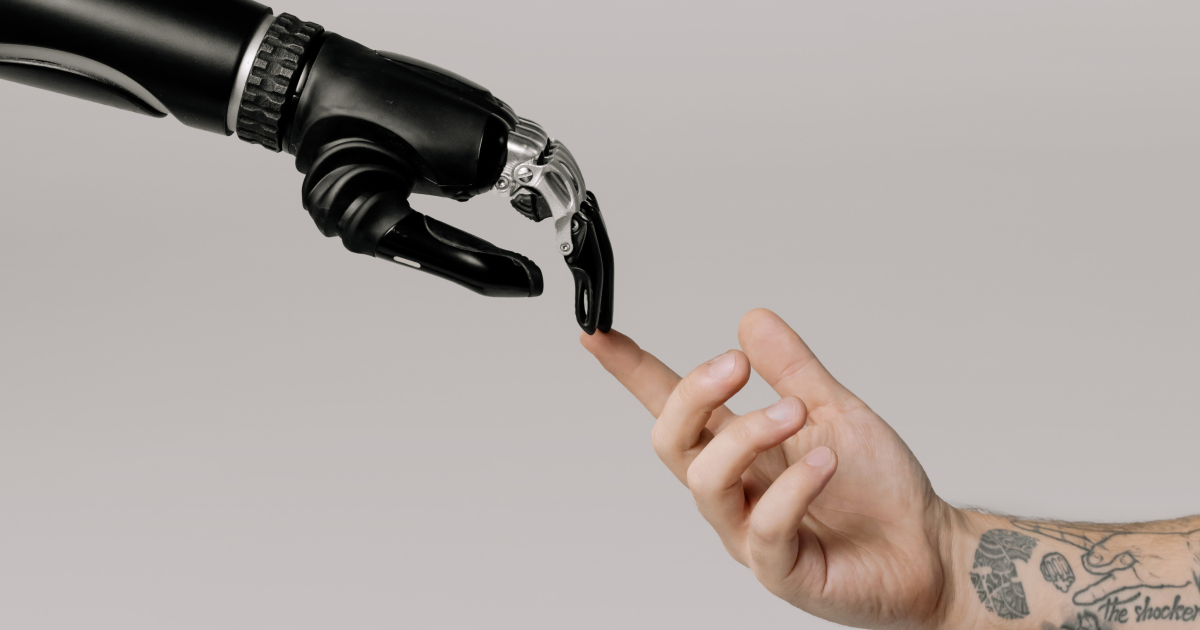
Healthcare tech trends in 2023
Aug 25
10 min read
Technology in healthcare is constantly evolving, and 2023 promises yet another year of significant changes for this sector. From wearables, to remote patient monitoring, to cybersecurity, several digital healthcare trends are emerging that could help reshape health tech in the year ahead.
Here are our predictions for the top trends that will impact the healthcare industry in 2023, and beyond.
Top digital healthcare trend predictions for 2023
Keeping apprised of changes in the health tech landscape can help established and startup companies adapt their strategies to align with emerging needs in the market. With this goal in mind, let’s dive into 14 significant trends expected to drive digital healthcare transformation in the coming months and years.
1. Internet of Medical Things (IoMT)
The Internet of Medical Things (IoMT) has catalyzed a significant shift in patient awareness, and the global market for wearables, such as fitness trackers and smartwatches, is expected to reach $34 billion by 2023.
Wearables and trackers give people access to real-time data about their daily activities, which can encourage them to lead healthier lifestyles. Gamification features in some wearable devices can reward patients and motivate them to stick to healthy habits.
Doctors can receive notifications and participate in patients' treatment more actively than ever. Types of data that can be collected include sleep patterns, nutrition habits, average activity level, and other metrics. Healthcare practitioners can use this information to build more personalized coaching programs and track treatment progress more accurately.
While these devices can be used for promoting general wellness by tracking fitness goals or monitoring sleep patterns, they can also potentially transform healthcare in more profound ways. Wearable devices can monitor vital signs and provide real-time detection of, for example, a heart arrhythmia that could signal a heart attack. Additionally, the data collected can be used to improve population health by providing clusters of health metrics for large groups of users.

2. Greater focus on preventative medicine
For the last century or so in the Western world, looking after one’s health has been a largely reactive activity; healthcare generally happened only once someone had become sick or injured, and it consisted of treatment (often more targeted at relieving symptoms than addressing their root cause). This approach has contributed to a healthcare system inundated with huge costs and poor patient outcomes, because it’s nearly always more difficult, and costly, to solve a medical problem than to keep it from happening in the first place.
However, recent wellness trends have elevated the idea of self-care as a more proactive practice, and consumer health tech has played an important role in this shift. Many people now use fitness wearables and daily wellness tools to prevent or manage chronic issues such as diabetes, circulation, dehydration, and depression. Employers may also offer wellness products like access to athletic classes and meditation apps to maintain fitness and prevent chronic disease.
Wearables and digital health platforms track biomarkers that indicate wellness and illness, giving users visibility into their health metrics and illuminating preventative risk factors early. Storing this information digitally can make it easier to share it with providers for more sustained, comprehensive health analysis.
3. Improved cybersecurity and data privacy
As the frequency of data breaches continues to rise, security and privacy are becoming increasingly prioritized in the healthcare industry. Healthcare organizations must implement robust security protocols to safeguard patient data. Looking forward, more healthcare institutions are expected to adopt advanced security measures like biometric authentication, encryption, and more stringent regulations to ensure patient data confidentiality.
However, the healthcare industry faces significant data security and cybersecurity challenges. Current focus areas for improving cybersecurity measures include IoMT devices, threat detection, and AI-powered diagnostic tools.

4. Remote patient monitoring (RPM)
Remote Patient Monitoring (RPM) has emerged as a significant force in the healthcare industry, accelerated by the COVID-19 pandemic. RPM offers a wide range of opportunities, including online appointments, remote care, and video conferencing, and has contributed significantly to health equity by providing access to health services that might otherwise have been inaccessible due to a patient’s geographical, social, economic, and political situation.
5. Next-gen analytics
Frost & Sullivan predicts that integrating AI technology into healthcare data analytics could save the healthcare industry at least $150 million by 2025. AI's real-time and remote analysis of patient data show great potential for providing cost-effective solutions, which has already spurred an increase in AI technology adoption by the healthcare industry.
The COVID-19 pandemic has demonstrated the critical importance of data analytics and real-time decision-making in the healthcare sector. The volume of patient data makes manual processing impractical. Therefore, the future of the healthcare industry will rely heavily on technology that can process big data and provide real-time analytics for decision-makers.
Predictive analytics can provide data-driven insights from previous patient interactions, promoting more accurate treatment plans and timely services. They can also help healthcare providers optimize staff and control the supply chain.
To improve data management, healthcare organizations must implement better policies and processes for data governance and invest in data quality improvement programs and analytics capabilities. Although this requires a substantial investment of time, money, and resources, the potential to improve patient care and outcomes is significant.
In today's world, where consumers expect instant gratification and on-demand services, the healthcare industry must keep pace. Healthcare organizations must modernize their care delivery models to meet patient expectations and maintain competitiveness.

6. Advancement of AI and ML in healthcare
Artificial intelligence and machine learning have become essential technologies in the healthcare industry, helping clinicians to predict, diagnose, monitor, and treat patients more effectively. The global AI-in-healthcare market is expected to reach $20.65 billion in 2023 and is projected to grow at an annual rate of 37% from 2022 to 2030, reaching $187.95 billion by 2030. PwC reports that 73% of healthcare executives are confident that deep learning, natural language processing, and predictive analytics will significantly improve their companies' ability to treat onsite and remote patients.
Several top use cases for AI in healthcare include medical image analysis, drug discovery, brain diseases, and preventive medicine. Advances in these areas will be fueled by the increased prevalence of digital health records and personal health data supplied through other sources, such as remote patient monitoring.
According to a recent study, AI can help healthcare organizations reduce operational costs by up to 30%. This technology can also empower medical professionals to create personalized patient treatment plans based on their needs and choices.
7. Cloud migration
The healthcare industry is primed for significant changes in 2023, particularly in technology infrastructure and operations transformation. The pandemic's lingering impact continues to create persistent challenges relating to staffing, supply chain issues, security threats, and evolving compliance requirements. The demand for increased versatility, connectivity, and value is driving the industry to adopt new technologies, including a massive shift towards cloud-based systems.
The adoption of cloud technology holds the potential to unseat the sector's deep-seated intransigence in adopting new technologies. Moving away from on-prem to cloud environments is expected to continue, and 2023 may finally be "The Year of the Healthcare Cloud" as strategies for future-proofing IT infrastructure take hold.
8. Process automation
Changes to healthcare tech infrastructure and operations transformation are at the forefront in 2023. The COVID-19 pandemic has worsened the shortage of healthcare workers, which is predicted to reach 12.9 million professionals by 2035, according to the World Healthcare Organization.
Healthcare organizations are increasingly adopting robotic process automation (RPA) solutions to address resource challenges. RPA-powered bots can automate various tasks, such as information management, appointment scheduling, claims management, care delivery, and hospital management, promoting accuracy, cost efficiency, and optimal staffing.
Adopting RPA and AI can free up nurses and doctors to spend more time with patients, enabling more accurate and timely diagnosis and treatment. Additionally, AI algorithms may help patients determine what kind of healthcare provider might be best equipped to address a specific health concern, allowing them to get the treatment they need more quickly and efficiently.
9. FinTech integration
Healthcare spending is projected to reach $6 trillion by 2027, prompting the healthcare industry to turn to technology for improved filing and billing processes. Financial technology, or fintech, offers a range of services, including insurance, asset management, payments, settlements, capital-raising, deposits, and credit, which can lower the cost of financial services and streamline healthcare processes.
Fintech solutions such as robotic investment advice, peer-to-peer lending, mobile payments, artificial intelligence, machine learning, and blockchain technology can mitigate inefficiencies in payment plans, making healthcare more accessible and affordable for low to moderate-income individuals and reducing income inequality and financial exclusion.
Additionally, digital financial service technologies can benefit patients, payers, and providers by supplying digital savings, credit and lending, insurance, crowdfunding, and enterprise financial management platforms for improving services. Insurtech solutions offer convenience and faster reimbursement for healthcare providers, leading to increased financial protection and understanding of patient benefits.
10. Interoperability and connectivity will increase
One of the most widely recognized challenges facing the healthcare industry is the need for greater interoperability among health data management systems. This issue has slowed down the pace of care for years, across virtually every type of health setting. Enhancing the interoperability and connectivity of medical devices has become essential to unblocking future health tech evolution, giving rise to a growing contingent of digital health innovators dedicated to improving patient data flow, synchronization, and quicker and more accurate identification of high-risk patients, ultimately improving outcomes.
According to a study conducted by Google, nearly 59% of doctors believe better interoperability will help them more quickly identify high-risk patients, and 95% of doctors agree that enhanced interoperability will improve patient outcomes.
The US Department of Health and Human Services (HHS) has recently finalized rules that give individuals greater control in sharing health information, basing them on a consumer-centric approach to healthcare. Patients can now access and share their electronic health information more easily. Furthermore, interoperability between providers and MedTech developers is expected to improve, and we expect to see massive growth in the field in the upcoming years.

11. Telehealth will become the norm
Telehealth has become much more common since the pandemic and may someday become the norm in many areas of healthcare delivery. Patients are increasingly interacting with their doctors and care team through video conferencing, phone calls, and text messages, facilitated by the convenience and affordability of telehealth services. The use of mobile devices and wearable technology is also contributing to this shift.
The global telehealth market is expected to experience explosive growth, reaching $175.8 billion by 2025, up from $38.3 billion in 2018. This expansion is fueled by various factors, including the increasing adoption of telehealth services by healthcare providers, the growing number of patients using telehealth services, and the expanding use of mobile devices and apps for health management.
Telemedicine has already seen a significant uptick, with remote visits surging to 38 times those of pre-pandemic levels since February 2020, largely concentrated within the mental health space. With spending on mobile mental health applications reaching nearly $500 million in 2022, telehealth is expected to continue its trajectory toward becoming a critical medical technology in the healthcare sector in 2023.
12. Patient-centered medicine and care
Digital transformation in healthcare is driving a shift towards more personalized medicine, allowing healthcare providers to better understand patients' unique needs through data and analytics. This will enable more tailored and effective treatments and empower patients to take a more active role in their own care by accessing their health data. These changes could ultimately lead to better patient health outcomes and lower costs for the healthcare system.
Another significant trend in healthcare technology is the demand for a personalized patient experience. This is evident in the precision medicine market, which is expected to reach $146.6 billion by 2028, up from $65.9 billion in 2021. Implementing new medical technologies will place the patient at the center of the process. Healthcare providers can develop more effective treatment plans and achieve better outcomes by studying the specifics of each patient's condition.
13. 3D printing of prosthetics and implants
The use of 3D printing technology has the potential to transform the way prosthetics and implants are manufactured. With 3D printing, prosthetics and implants can be tailored to fit each patient's unique needs, eliminating the discomfort associated with ill-fitting prosthetics or implants. Furthermore, 3D printing enables the creation of prosthetics and implants using biocompatible materials, reducing the risk of infection or rejection.
The 3D-printed prosthetics market is predicted to grow from $0.96 billion in 2022 to $1.04 billion in 2023, with a compound annual growth rate (CAGR) of 8.8%. If the trend continues as predicted, the sector would reach $1.44 billion in 2027, with a CAGR of 8.4%.
14. Supply chain disruptions will emerge
Supply chain disruptions have created significant challenges for the healthcare industry in recent years, and this trend is expected to continue in the immediate future. As the industry becomes increasingly interconnected, with all stakeholders relying on each other to provide essential goods and services, disruptions in the supply chain could threaten patient health and safety.
One of the main reasons for these disruptions is the immense amount of data generated in the industry. RBC Capital Markets recently reported that the healthcare industry generated around 30% of the world's data volume in 2021 and is expected to reach 36% by 2025. The medical supply chain is experiencing a significant increase in the amount of data flowing in and out, and the pace and volume growth will likely continue.
Additionally, the healthcare industry’s increased adoption of cloud technologies can also contribute to supply chain disruptions. This trend is particularly relevant to eHealth, a complex and interconnected field. As a result, eHealth is also susceptible to disruptions.
Key takeaways
By improving the convenience, accessibility, and efficiency of healthcare services for patients and healthcare providers, the field of digital healthcare is constantly changing and modernizing the healthcare industry. Rapid technological advancement has facilitated the development of innovative healthcare solutions, which have revolutionized healthcare delivery.
As a result, it is critical for healthcare professionals and organizations to stay current on emerging trends and technologies in digital healthcare to provide the best possible care to their patients. By adapting to these changes, healthcare providers can provide faster, more accurate diagnoses and personalized treatment plans, ultimately improving the patient experience.
Jana DiSanti
Jana DiSanti leads content strategy for Twenty Ideas. She brings nearly a decade of digital marketing, content creation, user research, and project management expertise to the table to advance the goals of the 20i agency and its clients. She specializes in promoting brands and products focused on improving the health of people, communities, and the planet.
by this author





